Cultural Heritage Complex
- Part 3-
By: Mutua Bahadur *
TYPICAL BAMBOO ROOF HOUSE
This house is made of wood and fenced its wall with the mat of bamboo chip. The wooden plank is used for pile dwelling. The roof of this house is covered with a half portion of Maribob (Dendrocalamus hamiltonei, a kind of bamboo). The two half portion of bamboo are arranged by turning up its inner side and another one half portion is fixed in between the joining area. In this manner the bamboo covers the whole area of the roof. It is 10.80 m. in length and 2.70 m. in breath.
Wooden Utensils
The most of the tribal people used to made their utensil out of the trunk of a big tree, such as small mortar for making mixture of chilies, medium mortar for the spices, a dish in a suitable size of one meal of a man, small tub for washing clothes, and large tub-like object used in the common family meal to contain the cooked rice. There are also other wooden objects having tight lids such as mixture of local liquor, and storage for fishes, chilies, wooden spoons and ladles, and the small container for the stone used for producing fire spark, etc. There is a community owned large wooden mixture for local liquor and its size is 9.00 m. long and 1.80 m. in breath and thickness respectively.
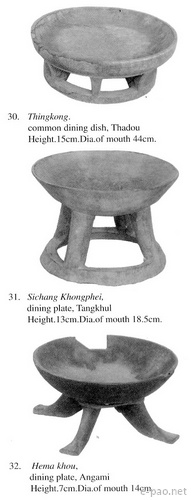
Fig. 11
Weaving Implements
From very early century, Meetei used to produce cloths in back strap/loin loom. This technique was developed into Pang Iyong (throw shuttle loom) in 1074. Then again the Meetei have adopted the knowledge of using Kol (Fly shuttle) in 1900. The loom and its implements are given to the daughters as one of the important gifts in the marriage ceremony. The Meetei used different implements, made of wood for making out thread of cotton and mulberry silk. Among them, Kaptreng (machine made of wood for cotton ginning) and Tareng (spinning wheel) etc. are important one. The Tamang a kind of twisting implement which is made of wood and bamboo chip is also used.
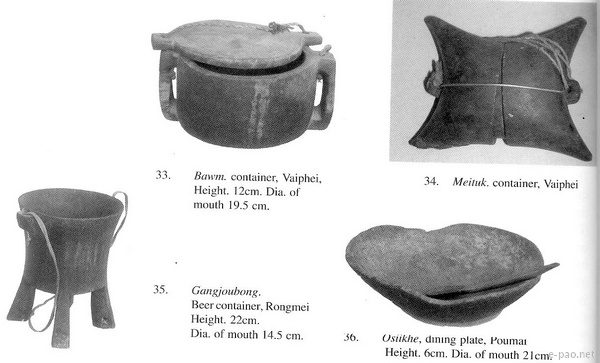
FIG 12
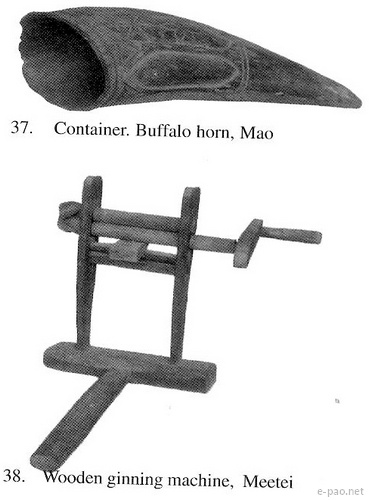
FIG 12
TYPICAL KABUI HOUSE
Among the tribes of Manipur the Kabuis are also included in the Schedule List. They are mainly concentrated in the Tamenglong District. This traditional house is the Ahong Yum or Talang Kai of the Kabui group. There are seven types of Talang Kai, such as
1) Pumchan Kai/Pumtan Kai,
2) Lakpui Kai,
3) Sianlonpui Kai/ Senloi Kai,
4) Hoi Kai,
5) Thingpu Kai,
6) Uche Kai and
7) Khong Kai.
This house is made of wood and bamboo and its roof is covered with thatch. The frontal side of the house is a little bit higher than the backside. It is 10.80 m. in length and 4.50 m. in breath. The frontal wooden wall makes a veranda of the house. There are many paintings of live experiences on the wall in order to remember for all times.
These paintings are sketched by the weathered rock of the hills. There is one important pillar of this house in the front. It is known as golden pillar that supports the main horizontal support beam. On this pillar they engraved the women's breasts.
We arranged to display within this typical Kabui house the various products of cane and bamboo crafts of Manipur and its neighbouring states.
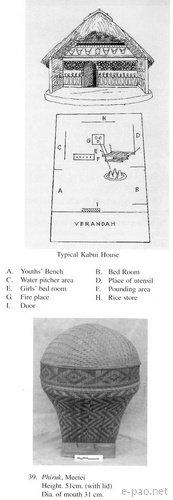
Fig 14
TYPICAL POUMAI HOUSE
The Poumai are also one of the Schedule Tribes of Manipur and mostly inhabited in Senapati District. They build a particular type of traditional house. This traditional house is known as Puki. Only the Chief of the village lives in this house.
The breath of this house is 6.60 m. in the frontal portion and 5.40 m. in the back portion. Its roof is slightly steep from the front towards the backside. At the top of the house, there is a cross-shaped sign on which the human heads collected by the heroes from the war of head hunting is engraved. The frontal wall of the house is made of wood and its thickness is 90 cm.
There are different forms of engraved with painting on the wall like tiger, heads of bulls, human heads, and men who bear the chop human heads and guns. The other three sides of the house are fenced with the mat of bamboo chip. The upper roof is covered with the plank of wood without iron nails and its size is 30 cm. in breath, 30 cm. and 45 cm. in length and 2.5 cm. in thickness.
The successive fold of wooden plank is tightened in the smoke rising from the in-house fireplace. They used wild creepers in order to tight the joining of the different parts of house. The inner side of the frontal wall is decorated by engraving human heads, tiger, etc.
We arranged to display within this typical Poumai house the various products of cane and bamboo crafts of Manipur and South East Asia.

Fig 15

Fig 16
DOLL HOUSE
It is made of wood and bamboo and its upper roof is covered with thatch. The breath and length of the house are 2.40 m. in each. In this house, there are dolls which represent the different communities of Manipur with their traditional dresses. The height of the doll is 20 cm.
TYPICAL TANGKHUL HOUSE
The Phen Sam is a typical house of Tangkhul who is one of the Schedule Tribes of Manipur. They are mainly concentrated in the Ukhrul District. This house is made of wood and bamboo. The upper roof of the house is covered with thatch and the plank of wood is used for walls of the house. The frontal side is a little bit higher than the backside.
At the top of the frontal side of the house there is a cross-shaped sign. The approximate size of the house is 4.50m. in breath and 11.10 m. in length. The frontal wall is made of wood (Michelia champaka) and its thickness is 15.5 cm. On the face of the frontal wall there are engravings of different shapes and forms of pictures such as human heads, dancing performance, the tiger's stripes, and paintings, which can tell a specific history of the community.
In this house, we displayed the different crafts of the traditional Tangkhul house. The exhibited items are the garland of human heads, breasts of women, undress women, heads of buffaloes and different shapes and sizes of dishes. There are also different musical instruments labeling names.
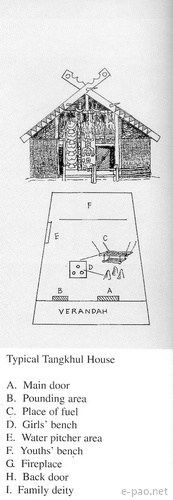
Fig 21
TYPICAL KOSO HOUSE
The Koso is an outhouse, which is prepared for boys and girls of Ahallup and Naharup Pana to live in at the time of the festival of Panam Ningthou. It is constructed within the campus of Panam Ningthou. The Koso is made of bamboo and its upper roof is covered with thatch. It is about 3.90 m. in breath and 9.00 m. in length. At the top of the house, there is a cross-shaped sign in the front and backsides of the house. In this house, we arranged to exhibit the different types of bamboo of Manipur.
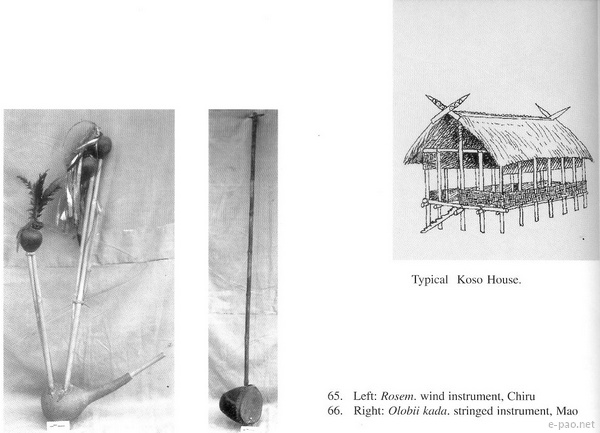
Fig 23
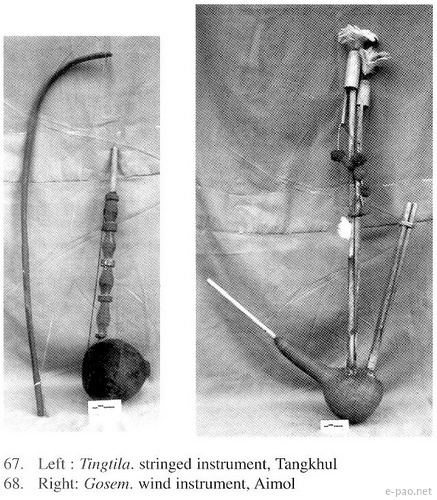
Fig 24
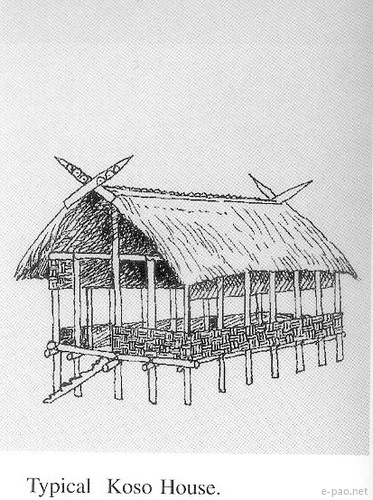
Fig 25
TYPICAL MAO HOUSE
The Opfa Opechii Koso Omee is a typical house of Mao tribes who are one of the indigenous groups enlisted in the Schedule List and concentrated in the Senapati district of Manipur. The house is made of wood and bamboo and its roof is covered with thatch. The pillars, lower horizontal beams, cross beams; lower roof supports are designed with the wooden materials.
A kind of bamboo in small size, which has been abundantly found in the hills of Dzuko, is used for upper roof supports. The wild creepers tightly fasten these bamboos. After that it was covered with thatch. There is a practice of roofing the house that the wife of the owner of the house starts to cover the upper roof supports with a single bunch of thatch from the backside of the house then the community members follow the process to finish the task.
Generally, the breath of the house is widening in the frontal portion 4.50 m. than the backside 4.20 m. It has also a slight slop from the frontal towards the backside and the wooden plank of the frontal wall has a little bit slanted in the front. The wall is made of the mate of bamboo chip.
The engraved frontal wall of wooden plank, which is normally used in Uningthou (Phoeba henesiana) has 60 cm. in breath and 1.8 cm. in thickness.
It is a work of sculptors by using a small iron tool. The sculptures are like the heads of buffaloes, swords, human heads, the men who bear human heads, etc. At the top of the house, there is a cross-shaped sign. And again at the top of the cross-shaped sign, there are the symbols of two cocks in C.I. sheet. According to the tradition, in every house of this type there is a scared place for fire.
In this house, we displayed textile cloths which are collected from different places like Manipur, other states of Northeast India and Southeast Asia. For every alternate 3 months we organize an exhibition of the textile cloths. The new collections are mainly exhibited in this programme.

Fig 26
See an accompanying gallery on this here.
To be continued ....
|
* Mutua Bahadur contributes to e-pao.net regularly. This article was webcasted on April 17, 2010.
* Comments posted by users in this discussion thread and other parts of this site are opinions of the individuals posting them (whose user ID is displayed alongside) and not the views of e-pao.net. We strongly recommend that users exercise responsibility, sensitivity and caution over language while writing your opinions which will be seen and read by other users. Please read a complete Guideline on using comments on this website.









